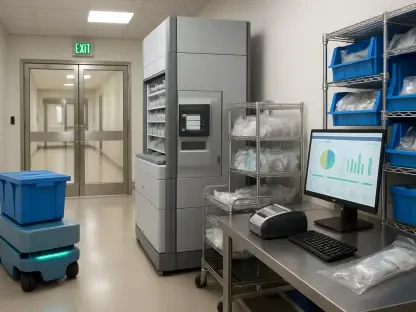The widespread presence of perfluoroalkyl and polyfluoroalkyl substances, known as PFAS, has emerged as a modern environmental and health challenge. Recognized for their persistence in the environment, these “forever chemicals” have steadily infiltrated various aspects of daily life, becoming a focal point of concern for health professionals and regulators alike. Ubiquitous in a plethora of household products—ranging from non-stick cookware to cosmetics—PFAS have been a growing subject of scrutiny due to their alleged links to serious health issues such as cancer and immune system deficiencies. This heightened awareness has propelled individuals like Dr. Rachel Criswell from Maine to take proactive steps in addressing the health impacts associated with PFAS. Her approach combines rigorous scientific understanding with practical clinical applications, aiming to bridge the gap between environmental health research and everyday medical practice.
Understanding PFAS and Their Impact
Despite their long-standing presence in industrial and consumer applications since the 1950s, PFAS have only recently come under the microscope for their potential health risks. These chemicals are characterized by their strong carbon-fluorine bonds, which make them resistant to degradation and persistent both in the environment and within human bodies. The ubiquity of PFAS has led to significant contamination of soil and water sources across the United States. Studies reveal that nearly half of U.S. tap water is contaminated with PFAS, a fact that underscores the gravity of their spread. Moreover, the Centers for Disease Control and Prevention (CDC) notes that a vast majority of Americans have measurable levels of PFAS in their blood, illuminating the pervasive nature of these substances and spurring concerns about their long-term implications on public health.
In response to these findings, states like Maine have spearheaded efforts to understand and mitigate PFAS exposure. The state has been at the forefront of testing water and soil to evaluate contamination levels, setting a precedent for other states grappling with similar challenges. This initiative gained urgency after the discovery of widespread contamination from the practice of land-spreading sludge containing PFAS—a common agricultural practice. Areas near industrial sites, landfills, and especially military bases, where PFAS-laden firefighting foam was used extensively, have been identified as hotspots requiring immediate remediation efforts. Through these comprehensive testing and policy initiatives, Maine not only highlights the complexity of PFAS contamination but also underscores the importance of localized, informed approaches to managing environmental health risks.
Dr. Rachel Criswell’s Role in Addressing PFAS
At the heart of Maine’s response to the PFAS crisis is Dr. Rachel Criswell, whose expertise combines medical knowledge with environmental health research. Recognizing the gap in knowledge and practice related to PFAS among healthcare professionals, Criswell has dedicated her efforts to enhancing awareness and understanding of these substances within the medical community. Her approach emphasizes education as a tool to empower clinicians to better diagnose, treat, and advise patients impacted by PFAS exposure. This involves not only disseminating the latest scientific findings but also adapting clinical practices to incorporate new insights on PFAS. As she navigates this complex landscape, Criswell’s work stands out as a testament to the crucial role medical professionals play in bridging scientific knowledge with actionable healthcare strategies.
Dr. Criswell’s advocacy is complemented by her involvement in state-funded initiatives aimed at controlling PFAS contamination. She participates in advisory committees tasked with allocating resources to address contamination problems stemming from past practices. This aligns with her dual commitment to immediate remediation and fostering long-term sustainability in managing PFAS risks. By leveraging her medical and research expertise, Criswell provides comprehensive guidance to others in the healthcare field. This includes detailed advice on testing procedures, interpreting results, and offering clear recommendations for minimizing PFAS exposure. In doing so, she not only enhances the capability of healthcare providers but also reinforces the broader public health infrastructure’s readiness to address environmental health concerns.
Bridging Science and Clinical Practice
One of the challenges faced by healthcare providers lies in keeping pace with rapidly evolving scientific insights into PFAS. Dr. Criswell’s work illuminates these difficulties, as clinicians strive to integrate new scientific data into established medical protocols. This challenge is particularly pertinent given the limited inclusion of environmental and occupational health in traditional and continuing medical education. To circumvent this, Criswell emphasizes the importance of resources like the 2022 report by the National Academies of Sciences, Engineering, and Medicine. This report provides a well-substantiated analysis linking PFAS exposure to various adverse health conditions, offering much-needed clarity to guide clinical decision-making processes.
This report has proved instrumental in reshaping the clinical approach to PFAS, prompting healthcare providers to treat PFAS exposure with the same seriousness as other recognized health risks. The report’s recommendations advocate for routine blood tests in populations known to be exposed to PFAS, thereby facilitating early detection and intervention. However, practical barriers such as the cost of testing and limited insurance coverage hinder the widespread adoption of these recommendations. To alleviate this, innovative solutions like finger-prick tests are being explored for their potential to provide more accessible means of monitoring PFAS levels. By navigating these complexities and advocating for policy changes, Dr. Criswell reinforces the crucial link between emerging scientific knowledge and its application in healthcare settings, ensuring that patient management strategies are informed by the latest research.
Community Engagement and Research Initiatives
Dr. Criswell’s efforts extend beyond traditional medical practice, encompassing a broader commitment to community engagement and collaborative research. Recognizing the diverse impacts of PFAS exposure, including mental health challenges, her work involves studying these effects in partnership with experts like pediatric endocrinologist Abby Fleisch. These collaborations aim to assess not only the physical but also the psychological stressors faced by individuals living in contaminated areas. By doing so, Criswell highlights the comprehensive nature of PFAS-related health concerns and underscores the need for a multidisciplinary approach to address them.
Community involvement is a key component of her strategy, as it ensures that research and interventions are tailored to the specific needs and concerns of affected populations. Engaging with residents of Central Maine, Criswell and her colleagues incorporate local insights into their studies, thereby enhancing the relevance and impact of their research. This participatory approach not only empowers communities but also fosters a sense of agency and collaboration in addressing PFAS-related issues. By fostering these connections, Criswell’s work exemplifies how personalized, community-centered research can drive more effective public health responses to environmental challenges.
The Evolving Landscape of PFAS Management
PFAS, long used in both industrial and consumer contexts since the 1950s, have recently been scrutinized for potential health hazards. Their robust carbon-fluorine bonds render them resistant to breaking down, resulting in their persistence in environments and human bodies alike. This endurance has led to widespread contamination of soil and water across the U.S. Alarming studies show that almost half of the nation’s tap water is tainted with PFAS, highlighting the widespread reach of these substances. Furthermore, the Centers for Disease Control and Prevention (CDC) reports that most Americans have detectable levels of PFAS in their blood, raising concerns about public health implications over time.
To address these issues, states such as Maine have taken decisive action to analyze and reduce PFAS exposure. Leading in testing efforts, Maine has evaluated water and soil contamination, setting a model for other states facing similar problems. This initiative became pressing after discovering extensive contamination from land-spreading sludge containing PFAS, commonly used in agriculture. Areas around industrial centers, landfills, and particularly military bases—where PFAS-filled firefighting foam was heavily deployed—are now identified as urgent zones needing clean-up. Through these initiatives, Maine illustrates not only the intricate issue of PFAS contamination but also emphasizes the significance of targeted, informed strategies to tackle environmental health risks effectively.









